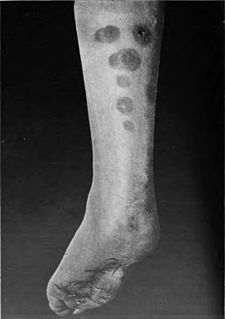Related Research Articles

A xanthoma, from Greek ξανθός (xanthós) 'yellow', is a deposition of yellowish cholesterol-rich material that can appear anywhere in the body in various disease states. They are cutaneous manifestations of lipidosis in which lipids accumulate in large foam cells within the skin. They are associated with hyperlipidemias, both primary and secondary types.

Panniculitis is a group of diseases whose hallmark is inflammation of subcutaneous adipose tissue. Symptoms include tender skin nodules, and systemic signs such as weight loss and fatigue.

Langerhans cell histiocytosis (LCH) is an abnormal clonal proliferation of Langerhans cells, abnormal cells deriving from bone marrow and capable of migrating from skin to lymph nodes. Symptoms range from isolated bone lesions to multisystem disease.
In medicine, histiocytosis is an excessive number of histiocytes, and the term is also often used to refer to a group of rare diseases which share this sign as a characteristic. Occasionally and confusingly, the term "histiocytosis" is sometimes used to refer to individual diseases.

Neonatal acne, often called neonatal cephalic pustulosis, is an acneiform eruption that occurs in newborns or infants, and is often seen on the nose and adjacent portions of the cheeks.
Non-X histiocytoses are a clinically well-defined group of cutaneous syndromes characterized by infiltrates of monocytes/macrophages, as opposed to X-type histiocytoses in which the infiltrates contain Langerhans cells. Conditions included in this group are:
Benign cephalic histiocytosis not to be confused with "Neonatal cephalic pustulosis" is a rare skin condition affecting boys and girls equally, characterized by skin lesions that initially present on the head in all cases, often the cheeks, eyelids, forehead, and ears.
Generalized eruptive histiocytoma is a rare cutaneous condition characterized by widespread, erythematous, essentially symmetrical papules, particularly involving the trunk and proximal extremities.
Xanthoma disseminatum is a rare cutaneous condition that preferentially affects males in childhood, characterized by the insidious onset of small, yellow-red to brown papules and nodules that are discrete and disseminated.
Progressive nodular histiocytosis is a cutaneous condition clinically characterized by the development of two types of skin lesions: superficial papules and deeper larger subcutaneous nodules.

Hereditary progressive mucinous histiocytosis is a very rare, benign, non-Langerhans' cell histiocytosis. An autosomal dominant or X-linked hereditary disease described on the skin, it has been found almost exclusively in women. One case of the disease in a male patient has been reported.
Reticulohistiocytosis is a cutaneous condition of which there are two distinct forms:
Reticulohistiocytoma is a cutaneous condition characterized by a solitary, firm, dermal skin lesion of less than 1 cm in diameter. It usually occurs in young adults or middle aged people, most commonly in females. Affected regions include the head and neck region and the upper part of the trunk. It may coexist with certain neoplasms or vasculitis, and in 30 percent of patients with xanthelasma.
Indeterminate cell histiocytosis is a cutaneous condition felt to be caused by dermal precursors of Langerhans cells.
Sea-blue histiocytosis is a cutaneous condition that may occur as a familial inherited syndrome or as an acquired secondary or systemic infiltrative process.
X-type histiocytoses are a clinically well-defined group of cutaneous syndromes characterized by infiltrates of Langerhans cells, as opposed to Non-X histiocytosis in which the infiltrates contain monocytes/macrophages. Conditions included in this group are:
Congenital self-healing reticulohistiocytosis is a condition that is a self-limited form of Langerhans cell histiocytosis.
Cutaneous actinomycosis is a chronic disease that affects the deep subcutaneous tissue of the skin. Caused by an anaerobic, Gram-positive, filamentous type of bacteria in the genus Actinomyces, invasion of the soft tissue leads to the formation of abnormal channels leading to the skin surface that discharge pale yellow sulfur granules.
Giant-cell reticulohistiocytoma is a cutaneous condition characterized by a solitary skin lesion.

The Histiocyte Society is an international network of people that co-ordinate studies of the histiocytoses, which it has divided into Langerhans cell histiocytosis, non-Langerhans cell histiocytoses, and malignant histiocytosis. They provided the criteria to definitively diagnose Langerhans cell histiocytosis.
References
- ↑ James, William D.; Berger, Timothy G.; et al. (2006). Andrews' Diseases of the Skin: clinical Dermatology. Saunders Elsevier. ISBN 978-0-7216-2921-6.
- ↑ Rapini, Ronald P.; Bolognia, Jean L.; Jorizzo, Joseph L. (2007). Dermatology: 2-Volume Set. St. Louis: Mosby. ISBN 978-1-4160-2999-1.
| This cutaneous condition article is a stub. You can help Wikipedia by expanding it. |